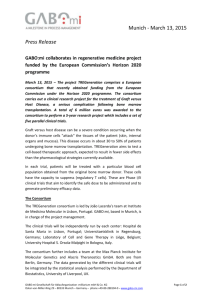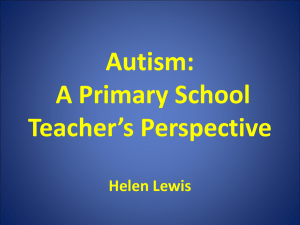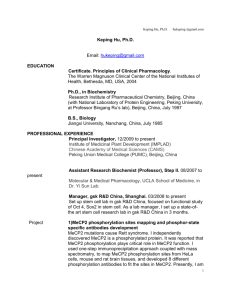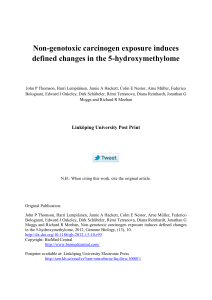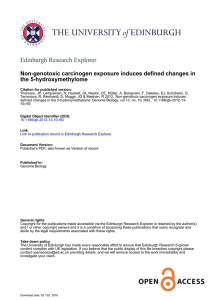Increased Binding of MeCP2 to the RELN and GAD1 Promoters is
advertisement
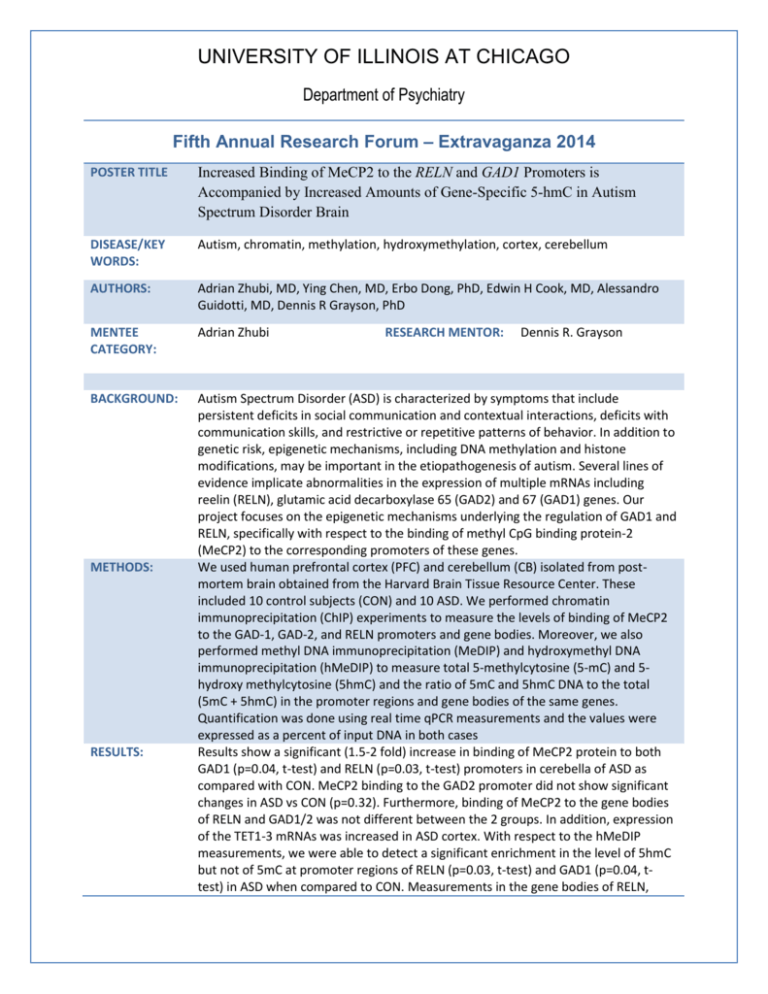
UNIVERSITY OF ILLINOIS AT CHICAGO Department of Psychiatry Fifth Annual Research Forum – Extravaganza 2014 POSTER TITLE Increased Binding of MeCP2 to the RELN and GAD1 Promoters is Accompanied by Increased Amounts of Gene-Specific 5-hmC in Autism Spectrum Disorder Brain DISEASE/KEY WORDS: Autism, chromatin, methylation, hydroxymethylation, cortex, cerebellum AUTHORS: Adrian Zhubi, MD, Ying Chen, MD, Erbo Dong, PhD, Edwin H Cook, MD, Alessandro Guidotti, MD, Dennis R Grayson, PhD MENTEE CATEGORY: Adrian Zhubi BACKGROUND: Autism Spectrum Disorder (ASD) is characterized by symptoms that include persistent deficits in social communication and contextual interactions, deficits with communication skills, and restrictive or repetitive patterns of behavior. In addition to genetic risk, epigenetic mechanisms, including DNA methylation and histone modifications, may be important in the etiopathogenesis of autism. Several lines of evidence implicate abnormalities in the expression of multiple mRNAs including reelin (RELN), glutamic acid decarboxylase 65 (GAD2) and 67 (GAD1) genes. Our project focuses on the epigenetic mechanisms underlying the regulation of GAD1 and RELN, specifically with respect to the binding of methyl CpG binding protein-2 (MeCP2) to the corresponding promoters of these genes. We used human prefrontal cortex (PFC) and cerebellum (CB) isolated from postmortem brain obtained from the Harvard Brain Tissue Resource Center. These included 10 control subjects (CON) and 10 ASD. We performed chromatin immunoprecipitation (ChIP) experiments to measure the levels of binding of MeCP2 to the GAD-1, GAD-2, and RELN promoters and gene bodies. Moreover, we also performed methyl DNA immunoprecipitation (MeDIP) and hydroxymethyl DNA immunoprecipitation (hMeDIP) to measure total 5-methylcytosine (5-mC) and 5hydroxy methylcytosine (5hmC) and the ratio of 5mC and 5hmC DNA to the total (5mC + 5hmC) in the promoter regions and gene bodies of the same genes. Quantification was done using real time qPCR measurements and the values were expressed as a percent of input DNA in both cases Results show a significant (1.5-2 fold) increase in binding of MeCP2 protein to both GAD1 (p=0.04, t-test) and RELN (p=0.03, t-test) promoters in cerebella of ASD as compared with CON. MeCP2 binding to the GAD2 promoter did not show significant changes in ASD vs CON (p=0.32). Furthermore, binding of MeCP2 to the gene bodies of RELN and GAD1/2 was not different between the 2 groups. In addition, expression of the TET1-3 mRNAs was increased in ASD cortex. With respect to the hMeDIP measurements, we were able to detect a significant enrichment in the level of 5hmC but not of 5mC at promoter regions of RELN (p=0.03, t-test) and GAD1 (p=0.04, ttest) in ASD when compared to CON. Measurements in the gene bodies of RELN, METHODS: RESULTS: RESEARCH MENTOR: Dennis R. Grayson UNIVERSITY OF ILLINOIS AT CHICAGO Department of Psychiatry GAD1 and GAD2 did not show significant differences between groups. CONCLUSIONS: Our data suggest that MeCP2 binding to RELN and GAD1 promoter regions is increased in ASD compared to CON, and that this might be the result of an enrichment of 5-hmC in the corresponding promoter regions in ASD. Further, we show that the expression of the TET1-3 proteins was higher in ASD cortex which correlates with the increased levels of 5hmC observed. Data from our studies are consistent with the hypothesis that increased expression of TET proteins (and other DNA modification proteins) facilitates increased 5hmC at specific gene regulatory domains.




